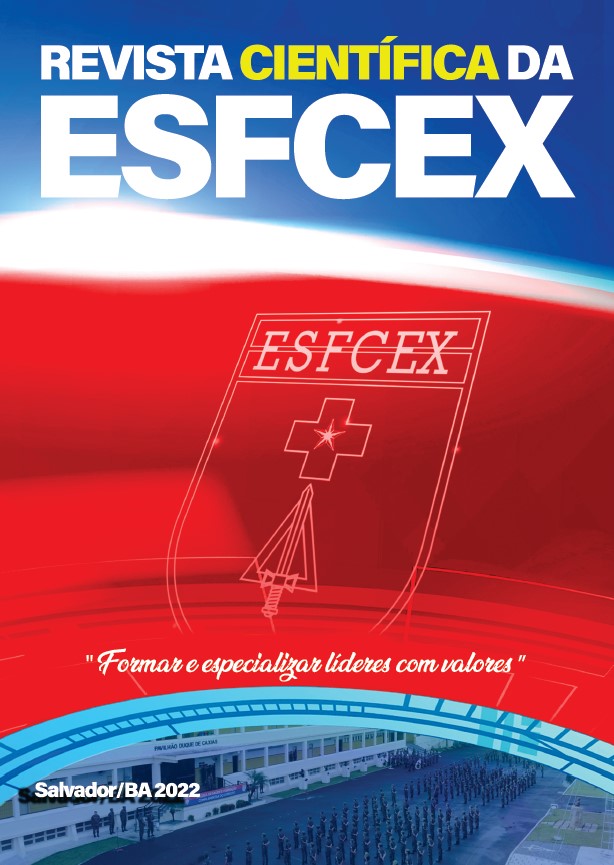O exame citopatológico do colo uterino como critério obrigatório nos concursos de admissão do Exército Brasileiro para candidatas menores de 25 anos
sua validade e aplicabilidade
Abstract
To prevent diseases prevalent in certain groups, such as cervical cancer in women, screening tests are necessary. Oncotic cer-vical cytology, the main screening method for these cases, is a quick, easy-to-perform and low cost test when a qualifi ed health professional is available to perform it. This is the main form of early diagnosis and treatment of cervical cancers. As they are the fourth leading cause of can-cer death in Brazilian women, their proper diagnosis allows improved survival rates. However, cervical cancer is rare in women up to 30 years of age and the peak of its incidence is in the age group of 45 to 50 years. Therefore, screening in the Brazilian population is recommended by the Ministry of Health for women between 25 and 64 years of age. In addition, as of 2014, the vaccine against HPV (Human Papillomavirus) was introduced. The method is eff ective in preventing cervical cancer and is included in the mandatory vaccination program for girls betwe-en 9 and 14 years old and boys between 8 and 13 years old. This study aims to evaluate the relevance of the mandatory request for a Pap smear test of the uterine cervix in the health inspection of all candidates for the admission exams of the Brazilian Army, considering that they are enrolled under the age of 25 and currently have a vaccination program against HPV completed. As so, a review of the narrative bibliographic literature was carried out in the Pubmed and Army Library databases. It was evidenced that the tracking of this pathology at an earlier age than recommended by the Ministry of Health is not relevant both from a socioeconomic point of view, because it has an epidemiological impact on diagnosis and treatment that is practically insignifi cant, and from a health point of view, considering that it can lead to more invasive exams and unnecessary treatments and bring negative consequences to the health of young women without still defi ned off spring. Thus, based on the scientifi c literature and on the guidelines of the main refe-rences that guide the theme – The Brazilian Federation of Gynecology and Obstetrics (Febrasgo), the Ministry of Health and the World Health Organization (WHO) – there is a non-compliance with the main scien-tifi c evidence on the obligation to carry out a cervical cytopathological examination performed in the health inspection of all candidates on the admission contests of the Brazilian Army, regardless of age and vacci-nation program.
References
BRASIL. Exército Brasileiro. Departamento Geral do Pessoal. Normas técnicas sobre perícias médicas no Exército. 2009. Disponível em: https://bdex.eb.mil. br/jspui/bitstream/1/648/1/Portaria%20n%c2%ba%20247%20 -%20DGP.pdf. Acesso em: 01 jul. 2022.
CARVALHO, S. H.; ROSA, D. A. N.; SANTOS, A. L. F.; MEDEIROS, A. P. P. Descrição dos encaminhamentos para colonoscopia em um hospital no Brasil. Revista Brasileira de Ginecologia e Obstetrícia, v. 42, n. 3, p. 140-145, 2020. Disponível em: https://doi.org/10.1055/s-0040-1708886. Acesso em: 13 jul. 2022.
FEBRASGO – Federação Brasileira das Associações de Ginecologia e Obstetrícia. Rastreio, diagnóstico e tratamento do câncer de colo de útero. São Paulo: FEBRASGO, 2017.
FERNANDES, José V. et al. Prevalence of human papilloma-virus in archival samples obtained from patients with cervical pre-malignant and malignant lesions from Northeast Brazil. BMC Research Notes, v. 3, n. 1, p. 1-6, 2010. Disponível em: https://doi. org/10.1186/1756-0500-3-96. Acesso em: 3 jul. 2022.
FRANCO, Eduardo L.; CUZICK, Jack; HILDESHEIM, Allan; SANJOSÉ, Silvia de. Issues in planning cervical cancer screening in the era of HPV vaccination. Vaccine, v. 24, n. 3, p. 171-177, 2006. Disponível em: https://doi.org/10.1016/j.vacci-ne.2006.05.061. Acesso em: 13 jul. 2022.
INCA – Instituto Nacional de Câncer José Alencar Gomes da Silva. Diretrizes brasileiras para o rastreamento do câncer do colo do útero. Coordenação de Prevenção e Vigilância. Divisão de Detecção Precoce e Apoio à Organização de Rede. 2. ed. rev. atual. Rio de Janeiro: INCA, 2016.
INCA – Instituto Nacional do Câncer. Controle do câncer de colo uterino: conceito e magnitude. Brasil, 3 jun. 2022. Disponível em: https://www.inca.gov.br/controle-do-cancer-do-colo-do-u-tero/dados-e-numeros/incidencia. Acesso em: 3 jul. 2022.
LIM, Tessa Si Chi; ISMAIL-PRATT, Ida; GOH, Lay Hoon. Cervical cancer screening and vaccination: understanding the latest guidelines. Singapore Me-dical Journal, v. 63, n. 3, p. 125-129, 2022. Disponível em: https://doi.org/10.11622/smedj.2022045. Acesso em: 13 jul. 2022.
NOVAES, Paulo Eduardo; ABRANTES, Maria Armanda Pinto; VIÉGAS, Célia Maria Pais. Câncer de colo do útero. In: INCA. 1º Seminário em Radioterapia. Rio de Janeiro: INCA, 2001. p. 39-78. Disponível em: https://www.inca.gov.br/sites/ufu. sti.inca.local/files//media/document//seminario-radioterapia-in-troducao.pdf. Acesso em: 13 jul. 2022.
RONCO, Guglielmo et al. Results at recruitment from a randomized controlled trial comparing human papillomavirus testing alone with conventional cytology as the primary cervical cancer screening test. Journal of the National Cancer Institute, v. 100, n. 7, p. 492-501, 2008. Disponível em: https://doi.org/10.1093/jnci/djn065. Acesso em: 13 jul. 2022.
SELLORS, John W.; SANKARANARAYANAN, Rengaswam. Uma introdução ao câncer invasivo do colo uterino. In: SELLORS, John W.; SANKA RANARAYANAN, Rengaswam. Colposcopia e tratamento da neoplasia intra epitelial cervical: manual para principiantes. International Agency for Research on Cancer, c2022. Disponível em: https://screening.iarc.fr/colpochap. php?lang=1&chap=3. Acesso em: 3 jul. 2022.
SIMÕES, Cleber de Sousa; MARINHO, Lucas Nogueira. Diagnóstico laboratorial das lesões precursoras do câncer de colo do útero: revisão. Brazilian Journal of Health Review, v. 4, n. 4, p. 15534-15558, 2021. Disponível em: https://doi.org/10.34119/bjhrv4n4-92. Acesso em: 13 jul. 2022
TAY, Sun Kuie; OON, Lynet-te Lin Ean. Prevalence of cervical human papillomavirus infection in healthy women is related to sexual behaviours and educational level: a cross sectional study. International Journal of STD & AIDS, v. 25, n. 14, p. 1013-1021, 2014. Disponível em: https://doi.or-g/10.1177%2F0956462414528315. Acesso em: 13 jul. 2022.
WHO – World Health Organization. WHO guideline for screening and treatment of cervical pre-cancer lesions for cervical cancer prevention. 2. ed. Geneva: World Health Organization; 2021. Disponível em: ht-tps://www.who.int/publications/i/item/9789240030824. Acesso em: 13 jul. 2022.



